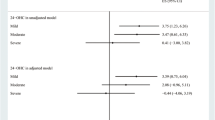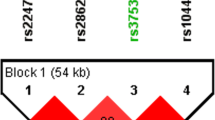Abstract
Cholesterol regulates the production of amyloid beta (Aβ), which is central to the pathogenesis of Alzheimer's disease (AD), with high cellular cholesterol promoting and low cellular cholesterol reducing Aβ in vitro and in vivo. High density lipoprotein (HDL) plays a central role in the removal of excess cholesterol from cells, and cholesteryl ester transfer protein (CETP) is a crucial protein involved in the regulation of HDL levels. Two common polymorphisms in the promoter region (C–629A) and exon 14 I405V of the CETP gene are associated with CETP activity and HDL levels. To investigate if these sequence variants in CETP might be of importance in mediating susceptibility to AD, independently or in concert with apolipoprotein E (APOE) ε4 allele, we studied a sample of 286 Spanish AD patients and 315 healthy controls. In APOE ε4 carriers, homozygous for the CETP (–629) A allele had approximately a three times lower risk of developing AD (odds ratio 2.33, 95% CI 1.01–5.37), than homozygous and heterozygous carriers of the CETP (–629) C allele (odds ratio 7.12, 95% CI 4.51–11.24, P for APOE ε4/CETP (–629) AA genotype interaction < 0.001). Our data suggest that CETP behaves as a modifier gene of the AD risk associated with the APOE ε4 allele, possibly through modulation of brain cholesterol metabolism.
Similar content being viewed by others
References
Albers JJ, Tollefson JH, Wolfbauer G, Albright RE Jr (1992) Cholesteryl ester transfer protein in human brain. Int J Clin Lab Res 21:264–266
Barzilai N, Atzmon G, Schechter C, Schaefer EJ, Cupples AL, Lipton R, Cheng S, Shuldiner AR (2003) Unique lipoprotein phenotype and genotype associated with exceptional longevity. JAMA 290:2030–2040
Blankenberg S, Rupprecht HJ, Bickel C, Jiang XC, Poirier O, Lackner KJ, Meyer J, Cambien F, Tiret L (2003) Common genetic variation of the cholesteryl ester transfer protein gene strongly predicts future cardiovascular death in patients with coronary artery disease. J Am Coll Cardiol 41:1983–1989
Boekholdt SM, Thompson JF (2003) Natural genetic variation as a tool in understanding the role of CETP in lipid levels and disease. J Lipid Res 44:1080–1093
Brewer HB (2004) Increasing HDL cholesterol levels. N Engl J Med 350:1491–1494
Dachet C, Poirier O, Cambien F, Chapman J, Rouis M (2000) New functional promoter polymorphism, CETP (–629), in cholesteryl ester transfer protein (CETP) gene related to CETP mass and high density lipoprotein cholesterol levels. Role of Sp1/Sp3 in transcriptional regulation. Arterioscler Thromb Vasc Biol 20:507–515
Dietschy JM, Turley SD (2001) Cholesterol metabolism in the brain. Curr Opin Lipidol 12:105–112
Fidani L, Goulas A, Crook R, Petersen RC, Tangalos E, Kotsis A, Hardy J (2004) An association study of the cholesteryl ester transfer protein TaqI B polymorphism with late onset Alzheimer's disease. Neurosci Lett 357:152–154
Gong JS, Kobayashi M, Hayashi H, Zou K, Sawamura N, Fujita SC, Yanagisawa K, Michikawa M (2002) Apolipoprotein E (ApoE) isoform–dependent lipid release from astrocytes prepared from human ApoE3 and ApoE4 knock–in mice. J Biol Chem 277:29919–29926
Gopalraj RK, Zhu H, Kelly JF, Mendiondo M, Pulliam JF, Bennett DA, Estus S (2005) Genetic association of low density lipoprotein receptor and Alzheimer's disease. Neurobiol Aging 26:1–7
Lambert JC, Luedecking–Zimmer E, Merrot S, Hayes A, Thaker U, Desai P, Houzet A, Hermant X, Cottel D, Pritchard A, Iwatsubo T, Pasquier F, Frigard B, Conneally PM, Chartier– Harlin MC, DeKosky ST, Lendon C, Mann D, Kamboh MI, Amouyel P (2003) Association of 3'–UTR polymorphisms of the oxidised LDL receptor 1 (OLR1) gene with Alzheimer's disease. J Med Genet 40:424–430
Macé S, Cousin E, Ricard S, Génin E, Spanakis E, Lafargue–Soubigou C, Génin B, Fournel R, Roche S, Haussy G, Massey F, Soubigou S, Bréfort G, Benoit P, Brice A, Campion D, Hollis M, Pradier L, Benavides J, Deleuze JF (2005) ABCA2 is a strong genetic risk factor for early–onset Alzheimer's disease. Neurobiol Dis 18:119–125
McKhaan G, Drachman D, Folstein M, Katzman R, Price D, Stadlan EM (1984) Clinical diagnosis of Alzheimer's disease: Report of the NINCDA–ADRDA Work Group under the auspices of Department of Health and Human Services Task Force on Alzheimer's disease. Neurology 34:934–944
Michikawa M (2003) The role of cholesterol in pathogenesis of Alzheimer's disease. Dual metabolic interaction between amyloid β–protein and cholesterol. Mol Neurobiol 27:1–12
Olesen OF, Dago (2000) High density lipoprotein inhibits assembly of amyloid β–peptides into fibrils. Biochem Biophys Res Commun 270:62–66
Papassotiropoulos A, Streffer JR, Tsolaki M, Schmid S, Thal D, Nicosia F, Iakovidou V, Maddalena A, Lütjohann D, Ghebremedhin E, Hegi T, Pasch T, Träxler M, Brühl A, Benussi L, Binetti G, Braak H, Nitsch RM, Hock C (2003) Increased brain β–amyloid load, phosphorylated tau, and risk of Alzheimer disease associated with an intronic CYP46 polymorphism. Arch Neurol 60:29–35
Poirier J (2003) Apolipoprotein E and cholesterol metabolism in the pathogenesis and treatment of Alzheimer's disease. Trends Mol Med 9:94–101
Puglielli L, Tanzi RE, Kovacs DM (2003) Alzheimer's disease: the cholesterol connection. Nat Neurosci 6: 345–351
Sánchez–Guerra M, Combarros O, Infante J, Llorca J, Berciano J, Fontalba A, Fernández–Luna JL, Peña N, Fernández– Viadero C (2001) Case–control study and meta–analysis of low density lipoprotein receptor–related protein gene exon 3 polymorphism in Alzheimer's disease. Neurosci Lett 316:17–20
Thompson JF, Lira ME, Durham K, Clark RW, Bamberger MJ, Milos PM (2003) Polymorphisms in the CETP gene and association with CETP mass and HDL levels. Atherosclerosis 167:195–204
Thompson JF, Lloyd DB, Lira ME, Milos PM (2004) Cholesteryl ester transfer protein promoter singlenucleotide polymorphisms in Sp1– binding sites affect transcription and are associated with high–density lipoprotein cholesterol. Clin Genet 66:223–228
van der Steeg WA, Kuivenhoven JA, Klerkx AH, Boekholdt SM, Hovingh GK, Kastelein JJP (2004) Role of CETP inhibitors in the treatment of dyslipidemia. Curr Opin Lipidol 15:631–636
Wolozin B (2004) Cholesterol, statins and dementia. Curr Opin Lipidol 15:667–672
Wollmer MA, Streffer JR, Lütjohann D, Tsolaki M, Iakovidou V, Hegi T, Pasch T, Jung HH, von Bergmann K, Nitsch RM, Hock C, Papassotiropoulos A (2003) ABCA1 modulates CSF cholesterol levels and influences the age at onset of Alzheimer's disease. Neurobiol Aging 24:421–426
Wollmer MA, Streffer JR, Tsolaki M, Grimaldi LME, Lütjohann D, Thal D, von Bergmann K, Nitsch RM, Hock C, Papassotiropoulos A (2003) Genetic association of acyl–coenzyme A: cholesterol acyltransferase with cerebrospinal fluid cholesterol levels, brain amyloid load, and risk for Alzheimer's disease. Mol Psychiatry 8:635–638
Yamada T, Kawata M, Arai H, Fukusawa M, Inoue K, Sato T (1995) Astroglial localization of cholesteryl ester transfer protein in normal and Alzheimer's disease brain tissues. Acta Neuropathol (Berl) 90:633–636
Yanagisawa K (2002) Cholesterol and pathological processes in Alzheimer's disease. J Neurosci Res 70:361–366
Author information
Authors and Affiliations
Corresponding author
Rights and permissions
About this article
Cite this article
Rodríguez, E., Mateo, I., Infante, J. et al. Cholesteryl ester transfer protein (CETP) polymorphism modifies the Alzheimer's disease risk associated with APOE ε4 allele. J Neurol 253, 181–185 (2006). https://doi.org/10.1007/s00415-005-0945-2
Received:
Revised:
Accepted:
Published:
Issue Date:
DOI: https://doi.org/10.1007/s00415-005-0945-2




